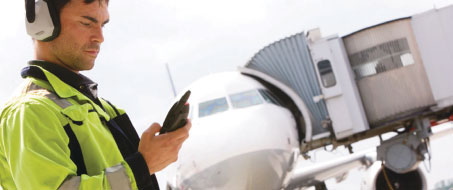
Within the next two or three years, airports around the world will take advantage of new mobilised applications. That way their ground staff will not only have the right information when they need it, but they will also be in the right location, with the right equipment, at the right time.
Over the past decade, mobile technologies have transformed every aspect of our lives. But in airports – which have a constantly mobile workforce – there are still many static, paper-based processes and voice-based communications, which hamper efficiency and reduce productivity.
If we can put intelligent, location-sensitive, data-based applications and services into the hands of airport ground workers, we will be able to introduce more flexible, agile and dynamic processes. These will be capable of delivering faster aircraft turnaround, better inventory control, more personalised assistance for passengers and smarter ways of absorbing disruption to daily flight schedules.
Within the next two or three years, airports around the world will take advantage of new mobilised applications. That way their ground staff will not only have the right information when they need it, but they will also be in the right location, with the right equipment, at the right time.
This will make an enormous difference to the performance of both routine and unplanned tasks – with better-quality decision-making and more efficient allocation of resources. We will also see a large proportion of voice communication migrate to data-centric handheld devices, which will help eliminate manual intervention from frontline activities; eradicate back-office logging activities; and speed up remedial action during disruptive events.
Good examples of areas where improvements can be delivered include aircraft maintenance, ramp management, passenger management, and baggage management – all of which have a direct impact on aircraft turnaround time. It has already been illustrated that with the right applications and mobile-enabled staff in place, one duty manager can simultaneously manage up to five turnarounds, which is far more cost-effective than today’s norm of one duty manager per aircraft turnaround.
Mobility solutions deliver the goods through a number of genuine improvements in processes and communications. They reduce the delay between decisions being made and actions being taken. They allow for immediate parallel notification of team members. They enable real-time resource management, by allowing events to be immediately assessed as they occur. And – because they’re data-centric – they reduce paperwork, human error and the time between an event happening and its consequences being recorded.
All of which is good for airports, airlines and other airport-based service providers – who will see enhanced productivity, increased efficiency, reduced costs, greater revenues and new opportunities for improved customer service. It’s a win-win situation – for airports, for airport staff, for airport customers, and, of course, for passengers too.
Free lost-found service

Travel Blue is developing new software which will enable airports globally to register lost property information onto a central website. Travel Blue’s software is being offered to airport authorities who would like to improve their customer service by becoming part of a global airport ‘lost property’ tracking system.
Travel Blue, the travel accessory company which introduced a Free-Lost-Found service for their customers at the end of last year, is now seeking to expand the principle behind uniting travellers with their lost possessions through a global airport system.
The company is developing new software which will enable airports globally to register lost property information onto a central website. Consumers can then track their lost property via the website and contact the airport once located.
Avi Levin, Travel Blue chairman, said: “Currently, lost property departments exist at airports, but management of all the items that are found is quite difficult and there is no unified system. Generally, travellers will have to remember exactly when and where they mislaid an item in order to have any remote chance of finding it again; during a stressful travel experience, where the number of airports/terminals involved could be significant, that can be almost impossible.”
Travel Blue’s software is being offered to airport authorities who would like to improve their customer service by becoming part of a global airport ‘lost property’ tracking system. The lost property department within the airport would simply need to load up the software and then, when lost property is handed in, register the item on the site, entering details such as airport, date, terminal, time, item description, etc. The software will automatically download the information onto the central website.







